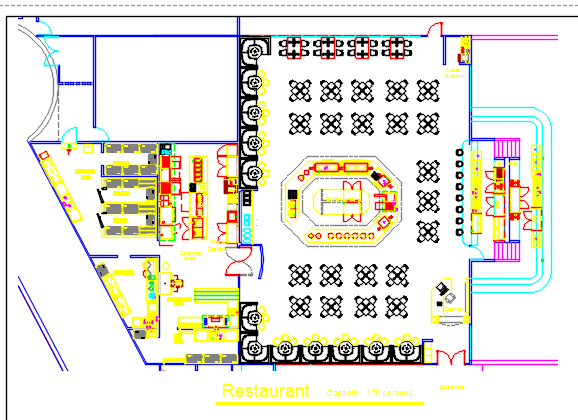What To Consider In Designing A New Restaurant

Restaurant Capacity Management What You Should Know
How to effectively capacity plan for your business.

Chapter 7 Capacity Planning And Management

How To Calculate Seating Capacity Of A Restaurant Bizfluent
Capacity planning is any strategy that is used to identify the amount of production required to satisfy the demand for the goods and services produced by a business. the idea is to balance the purchase of resources, the maintenance of production facilities, the hiring of labor, and the final output so that consumers have a steady supply of the products they desire. Gov. greg abbott's order dictates that restaurant capacity must be reduced to 50% occupancy and bars closed if the number of hospitalized coronavirus patients remains above 15% for seven days in a.

The Staff You Need To Hire To Run A Restaurant
Chapter 7: capacity planning and management learning outcomes after reading this chapter you should be able to: • define and measure capacity and appreciate the factors that influence it. • assess the difficulties of matching capacity to demand. • evaluate and apply the different strategies for matching capacity with demand in the short,. This paper studies the demand and capacity management problem in a restaurant system. a queueing-based optimization model with underlying quasi birth-and-death process and state-dependent functions. Let’s explore capacity planning concepts by briefly looking at a 24 hour restaurant. your restaurant, for most of the day, is calm and relaxed. the load is low and any small problem. Dec 02, 2020 · order reducing restaurant capacity, closing bars in north texas expected soon gov. abbott's order dictates that restaurant occupancy must be reduced to 50% if the number of hospitalized.
Safety regulations for capacity in accordance with square footage of the restaurant influences the layout and seating of a restaurant. on average and for fine dining, the range is 18-20 square feet (549-609 cm) capacity restaurant planning per person. full-service has one seat per 12-15 square feet (366-457 cm). By planning ahead for this staffing you will prevent excess servers from standing around and increase your profits by anticipating the additional customers. capacity planning enables you to make sure all the behind the scenes work is done so you are always ahead in the supply and demand chain. Capacity planning includes categories that help businesses based on the timelines they have established: short-term capacity: this is typically used for daily or weekly time frames. it can include quarterly time frames. short-term capacity doesn’t look at trends and cycles, but customer demand and seasonal variations. medium-term capacity: represents a one to three year timeframe.
Capacityplanning enables you to make sure all the behind the scenes work is done so you are always ahead in the supply and demand chain. the implications of capacity planning correctly can be far reaching and directly apply to your small business, no matter what it is. this tool needs to be incorporated into your business model and monitored. The problem of capacity management is one of the most difficult to tackle in business management; a situation which is aggravated in the majority of services, due to uncertain demand and personalized requirements, which make it difficult to plan and assign productive capacity. while overstaffing implies extra costs, insufficient capacity implies a lower level of attention to customer needs and.
Because restaurant capacity management, in principle, aims to keep things running at maximum efficiency, you waste less. with your kds wholly integrated with every device in your restaurant, every process is informed and calculated. your kitchen staff knows when to start an order and when to bump it. this saves time, effort and poorly-coursed meals dying under a heat lamp. your pickup and delivery entrees go out as scheduled, coursed to account for your kitchen, and their drive time. you improve your speed of service metrics on every front. finally, because you’re running at peak performance, you can process more orders and make more profit! This paper studies the demand and capacity management problem in a restaurant system. a queueing-based optimization model with underlying quasi birth-and-death process and state-dependent. Capacity planning can accelerate an organization’s innovation while decreasing risk. to help organizations meet demand, they must look at the different service demand factors that can affect capacity, including: 1. process: skills, quantity, and/or quality capabilities 2. staffing: job descriptions, total labor, training, compensation, and turnover rates 3. external factors: unions, governmental policies, and budget cycles when considering demand, service organizations benefit from the use of demand planning software. its features help match the needs of the business and offer “what-if” scenarios. demand forecastshelp service organizations with their financial plans and capacity to drive procurement that’s used to deliver their services. capacity planning that uses demand forecasts helps with pricing and contract terms that assist with times, locations, and timeliness of their services. when these are aligned, the service organization can better determine the future profitability of
You can't calculate seating capacity for your restaurant by just crunching numbers because there are so many variables. fine dining requires more space than fast food. a crowded small establishment looks more popular than a big empty venue. seating capacity should be part of your overall plan. Whether you’re a single-site independent or a national chain with sites in every mall and suburb, capacity management will help you. it’s not a feature predicated purely on volume, but upon the composite, often intangible, factors affecting your restaurant at a given moment. so, what might constitute a slow night for the 400-capacity buffet may set your single-stove kitchen into a frenzy. effective restaurant capacity management will pace meals and generate quotes according to the circumstances affecting your restaurant—not an arbitrary prediction. See full list on qsrautomations. com. In other words, it’s a measure of how much, and how effectively, your business can deliver, considering every factor. many industries use the term, from it to retail to hospitality, to analyze their effectiveness here. when determining restaurant capacity management, you’re measuring how well you manage your traffic, from on and off-site. when traffic increases, your restaurant gets closer to its capacity.

Steps to the capacity planning process with a hospital example. Restaurant capacity management is a simple technological feature with far-reaching benefits for your productivity, profit, and off-premise dining strategy. to maximize your restaurant’s potential, seek out a kitchen display system with capacity management features, and an ability to integrate, to craft a fully connected restaurant. When planning capacity there are always two sides to consider: firstly there is the demand the amount of the product or service that might be wanted; and secondly there is the provision of the good or service. Businesses can’t afford to guess when it comes to new services and opportunities. mistakes can be costly, which is one reason why capacity planning is crucial in considering their input requirements, conversion process, and output.
Strategies. the broad classes of capacity planning are lead strategy, lag strategy, capacity restaurant planning match strategy, and adjustment strategy. lead strategy is adding capacity in anticipation of an increase in demand. lead strategy is an aggressive strategy with the goal of luring customers away from the company's competitors by improving the service level and reducing lead time. See full list on vanguardsw. com. See full list on vanguardsw. com.
• the goal of capacity planning is to minimize this discrepancy. • capacity can be increased through introducing new techniques, equipment and materials, increasing the number of workers or machines, increasing the number of shifts, or acquiring additional production facilities. 6. Every restaurant has different space needs, but some generalizations can be useful in the initial planning stages. capacity restaurant planning in general, a large family restaurant might need up to 6,000 square feet, while a bistro or small diner with a lunch counter could get away with a smaller building of only half that size. of course, this is only an average figure.
0 Response to "Capacity Restaurant Planning"
Posting Komentar